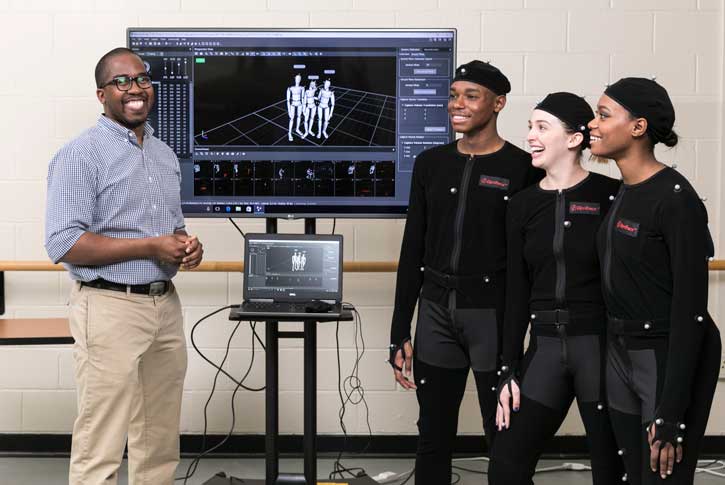
Bioengineering professor Wilsaan Joiner and the School of Dance are collaborating on research into sensorimotor learning. Photo by Ron Aira
How dancers move and learn may make them the perfect collaborators for Mason researchers. This new line of research brings together the Departments of Bioengineering and Psychology with the School of Dance in a whole new way.
As a bioengineer, Mason professor Wilsaan Joiner’s research interests include sensorimotor learning and control. One of his ongoing projects focuses on the neural processes underlying motor adaptation and memory consolidation. In the simplest terms, he studies how one learns a physical skill and retains that knowledge.
“When we study motor control, we study the human ability to learn and refine movement. In my scientific field, we talk about generalization, which basically is: I teach you how to move in A and then make it slightly different, let’s call that B. How much of what you learned for A transfers to B?” says Joiner.
“How we study this is ridiculously constrained,” he adds. “These experiments are typically very short-lived, usually over an hour over the course of one day. Learning motor skills over a period of months—that’s something that people don’t study.”
That’s why Joiner found the Mason dancers so fascinating. Not only do they learn a dance during a fixed period of time, and repeat that performance over and over, they can adjust their movements—as a group—to fit the performance space, such as moving from a rehearsal studio to an arts center stage.
Joiner asked how long it takes the dancers to make that transition, expecting an answer involving days or weeks. The response: a few minutes.
“How do you learn that step? How do you maintain the memory of it? It is a very sophisticated process,” says Mason dance professor Elizabeth “Buffy” Price. “We all have the skill, but [dancers] hone it.”
One of the first skills dancers learn when they come to Mason is a technique called “flocking.” It is a movement improvisation in which students mirror or shadow each other's movement in a group, following a leader around the room. The technique hones dancers’ proprioception, or their sense of their body in space.
This skill, and how dancers learn it, is something of particular interest to Mason cognitive psychologist James Thompson, who studies human movement and behavior. “In psychology, it is called ‘shared representation.’ You need to have a general awareness of where the other people are.”
One of the first things the team of researchers did was apply for a National Science Foundation grant and convert a dance studio in the de Laski Performing Arts Building into space where they could collect data using 3-D motion capture techniques.
“Straightaway, the group clicked,” says Thompson. “The grant proposal was just a first pass at trying to put a series of experiments down on paper. We are continually talking about side projects. I have about 10 years’ worth.”
Mason bioengineer Qi Wei, director of Mason’s Biomechanics Laboratory, is part of the team developing the computer models to replicate the dancers’ movement in the new lab.
They also included the development of an undergraduate class as part of the proposal. Tentatively called “Engineering Dance,” the class will bring together students from dance, engineering, psychology, and other fields to explore theories about learning and emotion, and how they relate to movement.
“In a way, dancers don’t realize what they know,” says Susan Shields, director of Mason’s School of Dance. “We are constantly trying to make sure our dance majors go out into the world confident, intellectually. That they understand that what they know translates into the real world. Hopefully, they are going to dance for years and years, but if not, then they have these skills.”
“There’s the research, but we are all interested in what this collaboration means for education and teaching,” says Thompson. “As a scientist, I want students who are creative and think outside the constraints of the field, students who work hard and are disciplined. It really doesn’t matter what their field is.”
